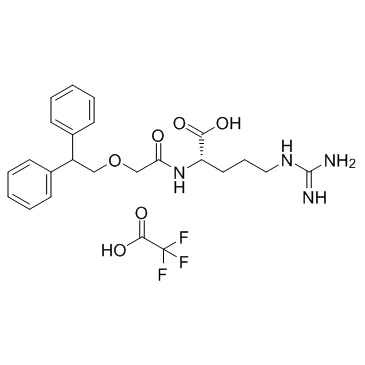| Description |
SB290157 trifluoroacetate is a potent and selective C3a receptor antagonist with an IC50 of 200 nM.
|
| Related Catalog |
|
| Target |
IC50: 200 nM (C3a)[1]
|
| In Vitro |
SB 290157, functions as a competitive antagonist of 125I-C3a radioligand binding to rat basophilic leukemia-2H3 cells expressing the human C3aR (RBL-C3aR), with an IC50 of 200 nM. SB 290157 blocks C3a-induced C3aR internalization in a concentration-dependent manner and C3a-induced Ca2+ mobilization in RBL-C3aR cells and human neutrophils with IC50s f 27.7 and 28 nM, respectively. SB 290157 is selective for the C3aR in that it does not antagonize the C5aR or six other chemotactic G protein-coupled receptors. SB 290157 also inhibits C3a-induced Ca2+ mobilization of RBL-2H3 cells expressing the mouse and guinea pig C3aRs. It potently inhibits C3a-mediated ATP release from guinea pig platelets and inhibits C3a-induced potentiation of the contractile response to field stimulation of perfused rat caudal artery[1].
|
| In Vivo |
SB 290157, inhibits neutrophil recruitment in a guinea pig LPS-induced airway neutrophilia model and decreases paw edema in a rat adjuvant-induced arthritis model[1]. The antagonist is able to reduce joint swelling only at 3 h, and about 50% inhibition of joint swelling is observed with the concentration of 30 mg/kg. The C3 level is significantly decreased at 3 h compared with naive mice showing complement consumption. Furthermore, the C3 activation is observed and increased corresponding to the graded concentration of anti-OVA pAb[2].
|
| Animal Admin |
Rats: SB 290157 is administered b.i.d. at 30, 10, and 3 mg/kg i.p. in a final volume of 0.5 mL starting on the day of adjuvant injection. Cages are modified to allow the compromised animals free access to food and water. Control animals are given vehicle alone. Change in paw volume is presented as mean and SEM of 10-12 animals/group, and the percentage inhibition of hind paw edema is calculated[1]. Mice: Administration of SB 290157, a C3aR antagonist, (10 or 30 mg/kg) is injected i.p. two times, at 0 (right after OVA injection) and 2 h while 5% ethanol in PBS is used as a vehicle control. Joint swelling is measured using a dial thickness gauge before injection, at 0.5 h, and then every hour until 5 h after OVA injection[2].
|
| References |
[1]. Ames RS, et al. Identification of a selective nonpeptide antagonist of the anaphylatoxin C3areceptor that demonstrates antiinflammatory activity in animal models. J Immunol. 2001 May 15;166(10):6341-8. [2]. Hutamekalin P, et al. Effect of the C3a-receptor antagonist SB 290157 on anti-OVA polyclonalantibody-induced arthritis. J Pharmacol Sci. 2010;112(1):56-63.
|
